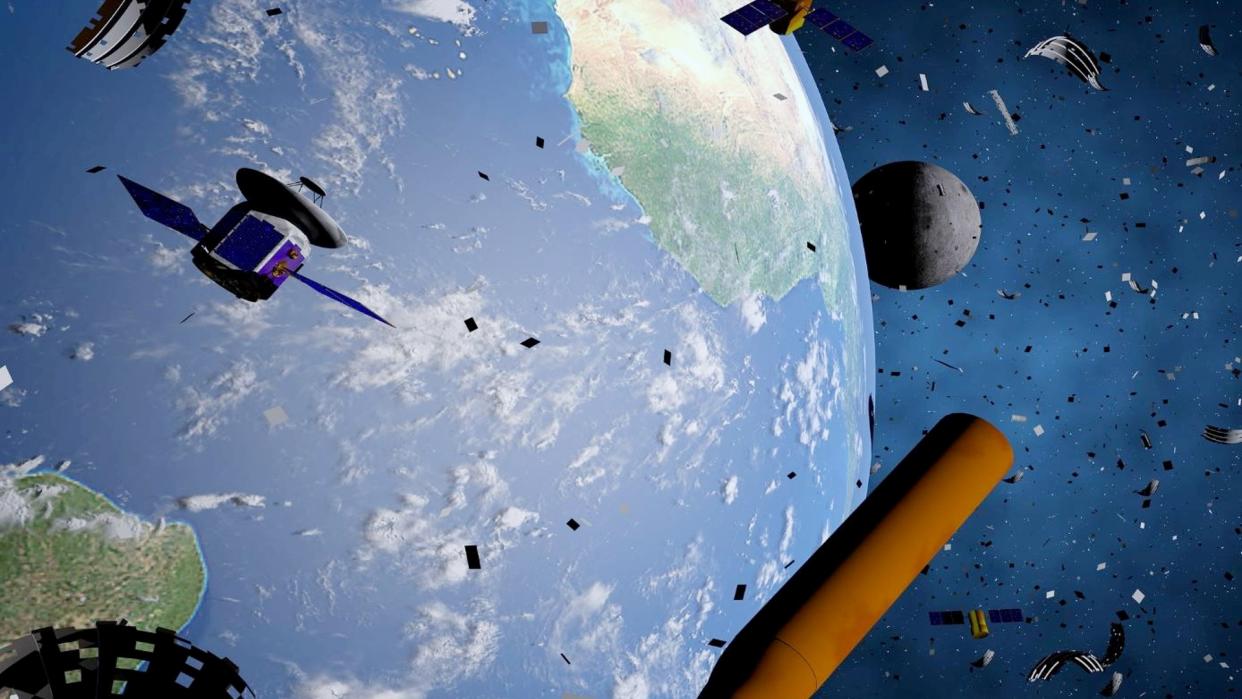Burned-up space junk pollutes Earth's upper atmosphere, NASA planes find

Scientists have long thought that the burning up of space junk in Earth's atmosphere creates air pollution that can affect the planet's climate. Now, for the first time, they've managed to detect the presence of these pollutants in the air high above our planet.
A team of researchers flew high-altitude NASA aircraft over Alaska and the U.S. mainland to sample the chemical composition of the thin air in the stratosphere, the second-lowest layer of Earth's atmosphere, which extends from about 6 miles to 30 miles (10 to 50 kilometers) above the planet's surface.
The planes, NASA's WB-57 and ER-2 aircraft, allowed the researchers to reach altitudes of up to 11.8 miles (19 km), which is about five miles (9 km) above the cruising altitude of commercial airliners.
Related: The rise of space tourism could affect Earth's climate in unforeseen ways, scientists worry
Sensitive sensors in the nosecones of the planes analyzed the chemical compounds diluted in the thin, pristine stratospheric air, which is out of reach of Earth-based air pollution sources. The researchers found traces of lithium, aluminum, copper and lead in the sampled air. The detected concentrations of these compounds were much higher than what could be caused by natural sources, such as the evaporation of cosmic dust and meteorites upon their encounter with the atmosphere. In fact, the concentrations of these pollutants reflected the ratio of chemical compounds present in alloys used in satellite manufacturing, the researchers said in a statement.
"We are finding this human-made material in what we consider a pristine area of the atmosphere," Dan Cziczo, a professor of Earth, atmospheric, and planetary sciences at Purdue University in Indiana and one of the authors of the study, said in the statement. "And if something is changing in the stratosphere — this stable region of the atmosphere — that deserves a closer look."
In recent years, scientists have been sounding alarm bells about the possible effects of the rising number of rocket launches and satellite re-entries on the upper layers of Earth's atmosphere.
For example, aluminum oxide, a product of the burn-up of aluminum-based alloys, is known for its ability to destroy ozone. Coincidentally, Earth's ozone layer, which protects life on the planet from harmful ultraviolet (UV) radiation, resides in the stratosphere, where the pollutants were found. The ozone layer has only just begun recovering from the destruction caused by the earlier use of ozone-depleting substances in refrigerators and aerosol sprays, and the pollution from space junk may set back its healing process.
On top of that, aluminum oxide particles can alter Earth's albedo, the planet's ability to reflect light, Aaron Boley, an associate professor of astronomy and astrophysics at the University of British Columbia in Canada, told Space.com in an earlier interview. Too-high concentrations of aluminum oxides in the stratosphere could therefore lead to temperature changes in the stratosphere which could, in turn, have unforeseen consequences for Earth's climate.
The problem is that particles dispersed at high altitudes are most likely never going to fall to Earth, Boley warned, which means that their concentrations are only going to rise with time.
RELATED STORIES:
— 2 big pieces of space junk nearly collide in orbital 'bad neighborhood'
— Clearspace-1 space debris cleanup target in orbit just got struck by space debris
— Private company wants to clean up space junk with 'capture bags' in Earth orbit
The advent of megaconstellations, large systems of satellites such as SpaceX's Starlink, has led to a steep increase in the number of satellites launched into orbit in recent years. Most of these satellites are designed to fall back to Earth and burn up in the atmosphere at the end of their missions. Tens or even hundreds of satellites may be launched in the coming decade, and that means a sharp increase in satellite re-entries and thus in the concentrations of chemicals created by their burn-up in the upper layers of the atmosphere.
"Changes to the atmosphere can be difficult to study and complex to understand," Cziczo said. "But what this research shows us is that the impact of human occupation and human spaceflight on the planet may be significant — perhaps more significant than we have yet imagined. Understanding our planet is one of the most urgent research priorities there is."
The study was published in the journal Proceedings of the National Academy of Sciences on Monday (Oct. 16).

